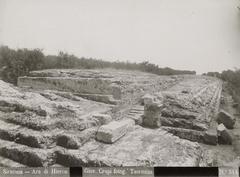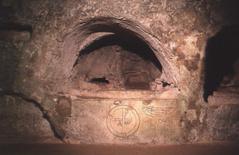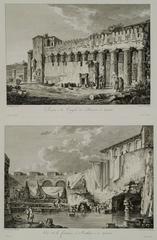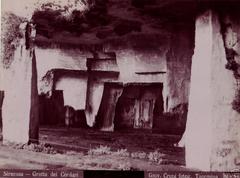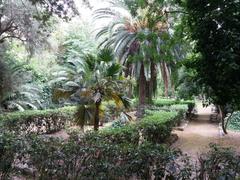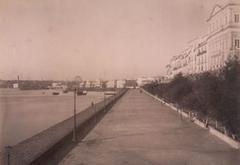Torre Tonda Visiting Hours, Tickets, and Travel Guide: Syracuse Historical Sites
Date: 14/06/2025
Introduction
Torre Tonda, a unique medieval round tower located in Syracuse, Sicily, stands as a powerful symbol of the city’s diverse history, strategic importance, and enduring architectural legacy. Overlooking the coastal area of Ognina and adjacent to the famed island district of Ortigia, Torre Tonda invites visitors to explore both its formidable exterior and the layered story of Syracuse’s defenses through the centuries. This comprehensive guide compiles all essential information—including visiting hours, ticketing, accessibility, travel tips, and nearby attractions—to help you make the most of your journey to one of Sicily’s most intriguing historical sites. For additional insights, see resources such as Italia.it, Antonio Randazzo, and The Geographical Cure.
Contents
- Introduction
- Historical Context of Torre Tonda
- Architectural Features and Defensive Role
- Cultural and Modern Significance
- Visitor Information: Hours, Tickets & Accessibility
- Practical Travel Tips and Nearby Attractions
- Frequently Asked Questions (FAQ)
- Explore More Syracuse Landmarks
- Summary and Final Tips
- References
Historical Context of Torre Tonda
Torre Tonda, or the “Round Tower,” traces its origins to the late medieval or early Renaissance era, likely constructed between the 14th and 16th centuries during the Aragonese or Spanish rule over Sicily (Italia.it). Syracuse, with its roots as a powerful Greek city-state and later a Roman, Byzantine, Arab, Norman, and Spanish stronghold, was constantly targeted by invaders and pirates due to its strategic coastal position. The construction of Torre Tonda was a response to these ongoing threats, reflecting advancements in military architecture and city defense.
The tower’s round design was a marked innovation for its time, offering increased resistance to cannon fire and providing defenders with an enhanced field of vision. Its position near the ancient city walls, close to critical entry points like Porta Marina and Castello Maniace, highlights its critical role within the city’s defensive network (Voyage Tips).
Architectural Features and Defensive Role
Torre Tonda is notable for its cylindrical shape, a departure from the square or rectangular forms typical of earlier towers. This design deflected projectiles more effectively and eliminated vulnerable corners, making it a formidable element of Syracuse’s defenses. The structure is built from local limestone, harmonizing visually with the rest of Ortigia’s historic architecture.
The thick walls—often exceeding two meters in width—were engineered to absorb artillery impact. Arrow slits and narrow windows provided both light and defensive vantage points. The upper platform, accessible via an internal spiral staircase, would have functioned as a lookout and as a station for archers and small artillery. Positioned along the perimeter of Ortigia, Torre Tonda formed an integral part of a broader network of fortifications, including other coastal towers and the imposing Castello Maniace (Antonio Randazzo).
The tower also participated in an early warning system, communicating with neighboring watchtowers via smoke signals and fire, which was vital in an era of frequent pirate raids and foreign incursions (Antonio Randazzo).
Cultural and Modern Significance
Beyond its military function, Torre Tonda has played an important role in shaping the identity of Ortigia and greater Syracuse. Its enduring silhouette anchors the local cityscape, and its preservation reflects the broader commitment to safeguarding Syracuse’s architectural heritage—a factor in the city’s UNESCO World Heritage status (Italia.it).
In modern times, Torre Tonda and its environs have become focal points for cultural events and heritage tours, providing both locals and visitors with a tangible link to the city’s long history. The surrounding area, rich in local life and vibrant markets, enhances the experience for those exploring Syracuse’s layered past (Greek Reporter).
Visitor Information: Torre Tonda Visiting Hours, Tickets & Accessibility
Location and Access
Torre Tonda is located in the Ognina area, just south of Syracuse’s historic core. It is easily reached by car via the SS115 and SP104 roads, or by train to Fontane Bianche halt, followed by a taxi or local bus (Italy Beyond the Obvious). The site is within walking distance of Ognina’s harbor and nearby beaches.
Visiting Hours and Tickets
- Visiting Hours: Torre Tonda is an open-air monument with no formal opening hours. The site is accessible at any time, though daytime visits are recommended for safety and visibility.
- Tickets: There is no entrance fee; the tower may be viewed freely from public areas. Interior access is generally not available due to private ownership, except during special events or by arrangement through local guides (Antonio Randazzo).
Accessibility
The terrain around Torre Tonda is natural and uneven, with gravel and rocky paths. There are no dedicated wheelchair-accessible ramps or handrails. Visitors with mobility challenges should plan accordingly and may prefer to view the tower from a distance or arrange accessible tours in Syracuse or Ortigia, where more accommodations are available (Italy Beyond the Obvious).
Facilities and Amenities
There are no visitor facilities (restrooms, cafés, or shops) at Torre Tonda itself. The nearby villages of Ognina and Fontane Bianche offer restaurants and basic services. For a full range of amenities, including hotels and pharmacies, visit Syracuse city center.
Practical Travel Tips and Nearby Attractions
- Best Time to Visit: March to June and October are ideal for mild weather and fewer crowds (The Geographical Cure).
- Footwear: Wear sturdy shoes for walking on uneven terrain.
- Photography: The tower and its coastal backdrop are especially photogenic at sunrise or sunset.
- Combining Visits: Torre Tonda can be combined with the Parco Archeologico della Neapolis, Castello Maniace, and Ortigia’s historic center (Voyage Tips).
- Guided Tours: While Torre Tonda itself is not regularly included in standard tours, private guides in Syracuse can create custom itineraries that feature the tower.
Nearby Highlights
- Ortigia Island: The heart of Syracuse, featuring the Duomo, Temple of Apollo, bustling markets, and picturesque waterfronts (The Orange Backpack).
- Parco Archeologico della Neapolis: Home to the Greek Theater and Roman Amphitheater (Italy Beyond the Obvious).
- Local Beaches: Fontane Bianche and Cala Rossa are excellent for swimming and relaxation.
- Nature Reserves: Plemmirio and Cavagrande del Cassibile offer hiking and birdwatching.
Frequently Asked Questions (FAQ)
Q: What are Torre Tonda’s visiting hours?
A: Torre Tonda is an open-air site with no official hours; daytime visits are recommended.
Q: Is there an entrance fee?
A: No, viewing Torre Tonda from public areas is free.
Q: Can I enter the tower?
A: Interior access is typically not available, as the tower is privately owned. Special access may be arranged during certain events or through private guides (Antonio Randazzo).
Q: Is the site accessible for wheelchair users?
A: The terrain is uneven and not fully accessible. Those with mobility issues should plan accordingly.
Q: Are guided tours available?
A: Not regularly at the tower itself, but private guides in Syracuse can include it in custom tours.
Explore More Syracuse Landmarks
- Piazza Duomo: Home to the Cathedral of Syracuse, blending Greek and Baroque architecture.
- Temple of Apollo: One of Sicily’s oldest Doric temples.
- Castello Maniace: A powerful medieval fortress at Ortigia’s southern tip.
- Jewish Quarter (Giudecca): Rich in history and cultural heritage.
- Ortigia Market: Experience local flavors in a vibrant setting.
For further exploration, see Wayless Travelers, Cat is Out of the Office, and Secret Places.
Summary and Final Tips
Torre Tonda stands as a testament to Syracuse’s resilience and strategic importance through centuries of change. Its distinctive round design, defensive role, and enduring presence offer a tangible link to the city’s dynamic history. While interior visits are rare due to private ownership and preservation needs, the tower’s exterior remains accessible and photogenic, especially when paired with a broader exploration of Ortigia and Syracuse’s other historical sites.
For a richer experience, consider guided walking tours that contextualize the tower within the city’s defensive network. Always check the latest visitor information through official tourism sources, embrace sustainable travel practices, and support local businesses. Downloading travel apps like Audiala can enhance your trip with up-to-date guidance and insider recommendations.
For more detailed insights and visitor support, consult Voyage Tips, Italia.it, and Traveling Italian.
References
- Italia.it – Syracuse: Necropolis of Pantalica
- Antonio Randazzo – Torre Tonda
- Italy Beyond the Obvious – Syracuse Guide
- The Orange Backpack – Things to Do in Syracuse/Ortigia
- Voyage Tips – Things to Do in Syracuse
- Greek Reporter – Ancient Greek Metropolis Syracuse
- Traveling Italian – Syracuse Travel Guide
- The Geographical Cure – 2 Days in Syracuse Itinerary
Enhance your visit with images of Torre Tonda’s limestone façade and panoramic coastal views. Use alt text like “Torre Tonda Syracuse limestone tower” and “View from Torre Tonda Ortigia” for SEO. Embedding a map of Ortigia with Torre Tonda’s location and virtual tour links can further enrich your planning.
